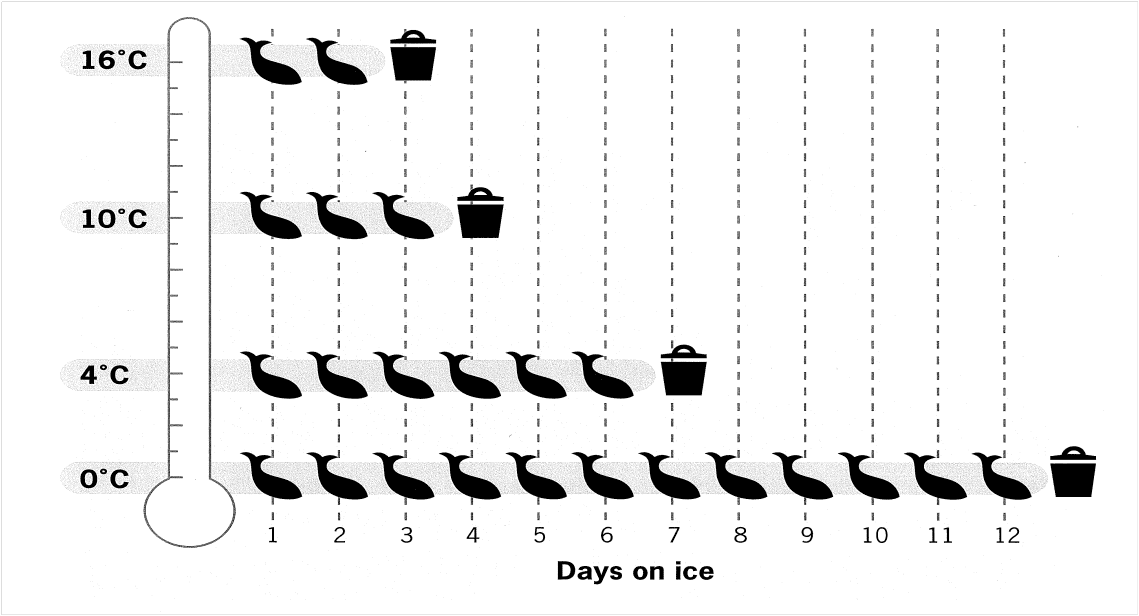Storing Seafood
Seafood begins to deteriorate as soon as it is caught and killed, this is irreversible during storage. We can’t stop product from deteriorating, but we can control the rate that product deteriorates.
Freshly caught seafood

To maximise the quality and shelf life of your seafood, place your catch in an ice slurry, or in the very least – on ice as quickly as possible after capture.
The diagram illustrates deterioration rates of seafood at varying temperatures. For example, seafood stored at 4ºC deteriorates twice as fast as seafood that is stored at 0ºC (0ºC is the temperature of melting ice).
Seafood that is stored at 16ºC deteriorates about 6 times as fast compared with storage at 0ºC.
Purchased seafood
Seafood will stay fresh longer if it’s kept cold. When shopping for seafood use a chiller bag or esky and ask your fishmonger to pack some ice with your purchase.
Refrigerating seafood
Scale, clean, and gut fish. Place on a plate, tray or in a container, cover with a damp cloth and then with plastic wrap or the lid. Store in the coldest part of the fridge and use within 2 – 3 days.
Clean and rinse squid, cuttlefish and octopus. Place on a plate or in a container, cover with a damp cloth and then with plastic wrap or the lid. Store in the coldest part of the fridge and use within 2 – 3 days.
Dead crustaceans (such as prawns) should be consumed as soon as possible after purchase. Refrigerate, covered with plastic wrap, on a plate or tray or in a covered container in the coldest part of the fridge.
Live crustaceans (such as crabs) should be consumed as soon as possible after purchase. Keep in a cool place with a damp cloth over the container ensuring that the cloth remains damp.
Live molluscs (such as mussels) should be consumed as soon as possible after purchase. Place in a container, cover with a damp cloth and keep in the warmest part of the refrigerator, usually the crisper (optimum 5°C), ensuring that the cloth remains damp. Before cooking discard any shells that are open and don’t close when tapped or gently squeezed.
Freezing seafood
Scale, gut, gill and wipe out all fish before freezing. Place in an airtight freezer bag, extract as much air as possible, label and date.
Whole non-oily fish can be frozen for up to 6 months at -18°C or less.*
Meat from molluscs (such as squid and mussels) can be frozen for up to 3 months at -18°C or less.* Gut and clean squid, cuttlefish and octopus or remove meat from shells. Place in an airtight freezer bag, extract as much air as possible, label and date.
Crustaceans can be frozen for up to 3 months at -18°C or less.* Place crustaceans (other than prawns) in an airtight freezer bag, extract as much air as possible, label and date.
Place unpeeled prawns in a plastic container. Cover with water, seal and freeze. This forms a large iceblock, which insulates the prawns. Do not add salt as it draws out the moisture. Label, date and freeze as above.
* Note: many domestic freezers do not get as low as -18ºC, if in doubt check.
www.sydneyfishmarket.com.au/seafood-school/cooking-info/faqs/faq-details?cat=2&id=94
This information is provided by the Sydney Seafood School at the Sydney Fish Market.
Learn more about the Seafood School.